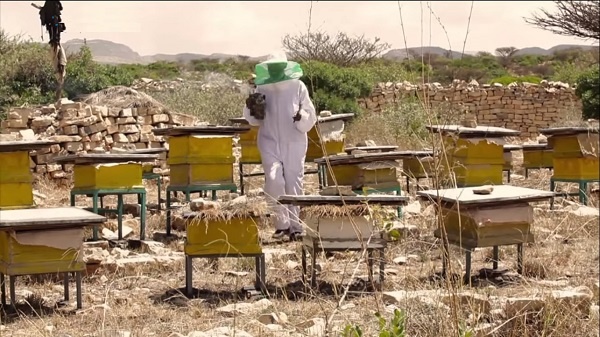
During 2019, 961 program participants in Ethiopia engaged in honey activities and supported the honey production of 28,048 kg of honey — generating an additional income of 3,861,800 birr
(Agrilinks) – With over one million households in Ethiopia keeping honeybees (an estimated 5.15 million hives), honey is an integral part of the agricultural sector. However, due to poor investment by farmers, associations, and government; unsuitable land; and a lack of training and skills, Ethiopia still produces only about 10 percent of its likely capacity of 500,000 tons a year.
Seeing this missed opportunity, the Strengthen PSNP4 Intuitional and Resilience (SPIR) Develop Food Security activity (funded by the Bureau for Humanitarian Assistance and implemented by World Vision, CARE and ORDA) aims to help link the honey value chain with wider project interventions in order to increase livelihoods for poor households and reclaim and restore valuable land and resources. SPIR facilitates the graduation of poor households from the Government of Ethiopia’s flagship safety net program call the Productive Safety Net Program (PSNP). The goal of SPIR is to enhance livelihoods, increase resilience against shocks, and improve food security and nutrition for rural households that are vulnerable to food insecurity in Ethiopia.
The reasons for low productivity in the honey sector stem from a variety of issues: a limited availability of bee forage (due to poisonous plants, seasonal availability, and deforestation); a lack of beekeeping knowledge; a shortage of trained apiculturists and beekeeping equipment; and pests, predators, and the usage of agricultural chemicals. Additionally, around 90 percent of the bee colonies in Ethiopia are kept in traditional hives which have an annual yield of 5-7 kg crude honey/year. A transitional hive can produce between 15-25 kg of honey per year, while the modern box hive can produce closer to 30-45 kg.
After conducting a value chain and market assessment, World Vision’s SPIR program identified North Wollo and Wag Himra zones in Amhara Region as having good potential to support the honey value chain. Among the diverse flora types in this area, is becium grandiflorum, “Mentese”, the main source for the production of white honey. Additionally, this area is clustered for honey production due to the high potential, and chemical application to crops is banned — although it is often difficult to enforce.
One of SPIR’s key interventions in this area is facilitating the training of 30 honey technicians (in collaboration with Sekota Dry Land Research Center) on colony multiplication, transitional hive making, transferring, splitting, and general beehive management skills. The trainees are local farmers who were also willing to provide low-cost services for PSNP clients in their communities like technical assistance, hive construction, and colony development. A colony multiplication and skill transfer center has also been established in Sekota Woreda, where farmers share experiences with others also engaged in the honey value chain. Twenty model honey farmers received training from government technicians on bee flora seeds and were linked to agro-dealers so that they can more easily procure these important seeds for their farms.
During 2019, 961 program participants engaged in honey activities and supported the production of 28,048 kg of honey — generating an additional income of 3,861,800 birr ($120,681).
The project also facilitated the construction of a communal pond for rainwater harvesting at Kurfa Chelle (using public works labor). The site selected was previously a damaged hill ecosystem, but it will be restored and used by 25 landless youth for income-generating activities such as forage development (specifically bee forage seeds) and beekeeping. This not only improves livestock feed resources and stabilizes land erosion, but it also contributes to the diversification of agriculture enterprises and income generation pathways through beekeeping.
The SPIR project has learned that honey can provide a sustainable and resilient livelihood pathway for income generation — particularly for women, youth, and landless households who engage in the value chain for supplemental income. The project has also seen that linking the honey value chain with wider project interventions (land restoration and reclamation and improved forage production for livestock) can lead to more diverse flora and a wider variety of plants for pollination, which contributes to a healthier ecosystem overall.
SPIR is helping to mitigate the barriers that stand in the way of Ethiopian honey farmers’ ability to achieve their full potential (500,000 tons of honey a year) by creating linkages to agro-dealers for affordable seeds and equipment, increasing their knowledge with capacity building, and working to improve the natural resources in their area.
We hope that in the future, Ethiopia’s honey sector can be a viable income stream, helping lift families out of poverty as well as playing a critical role in ecosystem balance and land restoration that benefits generations to come.
This post is written by John McCormack, World Vision.
About Agrilinks
Agrilinks is an online hub where agriculture, food security and development professionals connect, share and learn. Established in 2011, Agrilinks has become the go-to source for informative discussions on development topics and the latest information that is furthering resilience, food security and poverty reduction.
Source: Agrilinks
